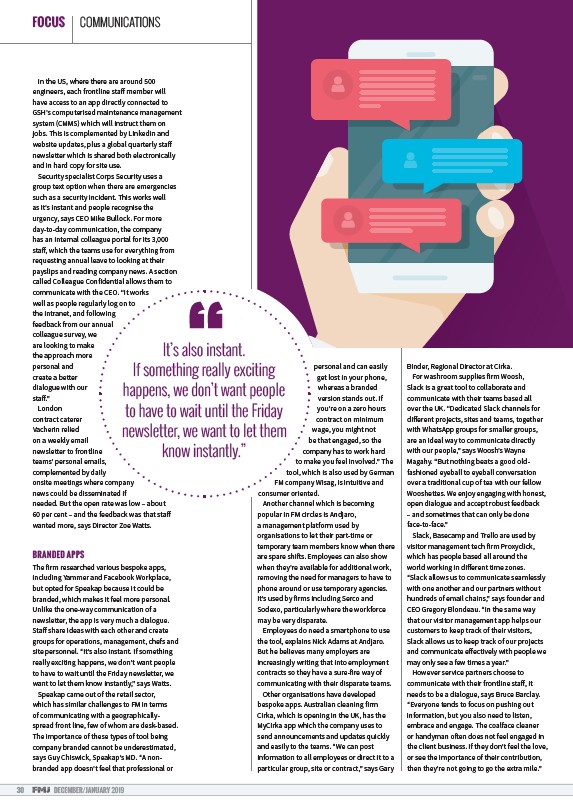
FOCUS COMMUNICATIONS
In the US, where there are around 500
engineers, each frontline sta member will
have access to an app directly connected to
GSH’s computerised maintenance management
system (CMMS) which will instruct them on
jobs. This is complemented by LinkedIn and
website updates, plus a global quarterly sta
newsletter which is shared both electronically
and in hard copy for site use.
Security specialist Corps Security uses a
group text option when there are emergencies
such as a security incident. This works well
as it’s instant and people recognise the
urgency, says CEO Mike Bullock. For more
day-to-day communication, the company
has an internal colleague portal for its 3,000
sta , which the teams use for everything from
requesting annual leave to looking at their
payslips and reading company news. A section
called Colleague Confidential allows them to
communicate with the CEO. “It works
well as people regularly log on to
the intranet, and following
feedback from our annual
colleague survey, we
are looking to make
the approach more
personal and
create a better
dialogue with our
sta .”
London
contract caterer
Vacherin relied
on a weekly email
newsletter to frontline
teams’ personal emails,
complemented by daily
onsite meetings where company
news could be disseminated if
needed. But the open rate was low – about
60 per cent – and the feedback was that sta
wanted more, says Director Zoe Watts.
BRANDED APPS
The firm researched various bespoke apps,
including Yammer and Facebook Workplace,
but opted for Speakap because it could be
branded, which makes it feel more personal.
Unlike the one-way communication of a
newsletter, the app is very much a dialogue.
Sta share ideas with each other and create
groups for operations, management, chefs and
site personnel. “It’s also instant. If something
really exciting happens, we don’t want people
to have to wait until the Friday newsletter, we
want to let them know instantly,” says Watts.
Speakap came out of the retail sector,
which has similar challenges to FM in terms
of communicating with a geographicallyspread
front line, few of whom are desk-based.
The importance of these types of tool being
company branded cannot be underestimated,
says Guy Chiswick, Speakap’s MD. “A nonbranded
app doesn’t feel that professional or
30 DECEMBER/JANUARY 2019
personal and can easily
get lost in your phone,
whereas a branded
version stands out. If
you’re on a zero hours
contract on minimum
wage, you might not
be that engaged, so the
company has to work hard
to make you feel involved.” The
tool, which is also used by German
FM company Wisag, is intuitive and
consumer oriented.
Another channel which is becoming
popular in FM circles is Andjaro,
a management platform used by
organisations to let their part-time or
temporary team members know when there
are spare shi s. Employees can also show
when they’re available for additional work,
removing the need for managers to have to
phone around or use temporary agencies.
It’s used by firms including Serco and
Sodexo, particularly where the workforce
may be very disparate.
Employees do need a smartphone to use
the tool, explains Nick Adams at Andjaro.
But he believes many employers are
increasingly writing that into employment
contracts so they have a sure-fire way of
communicating with their disparate teams.
Other organisations have developed
bespoke apps. Australian cleaning firm
Cirka, which is opening in the UK, has the
MyCirka app which the company uses to
send announcements and updates quickly
and easily to the teams. “We can post
information to all employees or direct it to a
particular group, site or contract,” says Gary
Binder, Regional Director at Cirka.
For washroom supplies firm Woosh,
Slack is a great tool to collaborate and
communicate with their teams based all
over the UK. “Dedicated Slack channels for
di erent projects, sites and teams, together
with WhatsApp groups for smaller groups,
are an ideal way to communicate directly
with our people,” says Woosh’s Wayne
Magahy. “But nothing beats a good oldfashioned
eyeball to eyeball conversation
over a traditional cup of tea with our fellow
Wooshettes. We enjoy engaging with honest,
open dialogue and accept robust feedback
– and sometimes that can only be done
face-to-face.”
Slack, Basecamp and Trello are used by
visitor management tech firm Proxyclick,
which has people based all around the
world working in di erent time zones.
“Slack allows us to communicate seamlessly
with one another and our partners without
hundreds of email chains,” says founder and
CEO Gregory Blondeau. “In the same way
that our visitor management app helps our
customers to keep track of their visitors,
Slack allows us to keep track of our projects
and communicate e ectively with people we
may only see a few times a year.”
However service partners choose to
communicate with their frontline sta , it
needs to be a dialogue, says Bruce Barclay.
“Everyone tends to focus on pushing out
information, but you also need to listen,
embrace and engage. The coalface cleaner
or handyman o en does not feel engaged in
the client business. If they don’t feel the love,
or see the importance of their contribution,
then they’re not going to go the extra mile.”
It’s also instant.
If something really exciting
happens, we don’t want people
to have to wait until the Friday
newsletter, we want to let them
know instantly.”